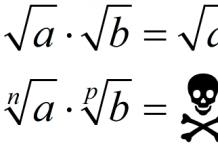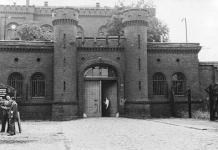One of the foundations of the Soviet idea of the Second World War is the myth that Germany’s attack on the USSR was for Hitler the ultimate goal of all military activities. They say that the victory over the Bolshevik USSR was the main reason for the World War. And of course, that’s why France and England brought Hitler to power, and armed Germany, and “surrendered” Czechoslovakia to Hitler - just so that he would attack the USSR.
Like other Soviet myths, this idea is not true. Hitler saw world domination as the ultimate goal of the World War - in the most literal sense of the word.
In 1940, when the plan for an attack on the USSR had already been drawn up in all details and preparations for its implementation had begun, Hitler and the German General Staff rated the Red Army extremely low. Therefore, it was planned to carry out “Barbarossa” in a fairly short time and begin the next operations in the fall. And these operations were not planned against the USSR at all (it was believed that after German troops reached the Arkhangelsk-Volga line, the remnants of the USSR would not pose a military threat) - the goal of the operations was to seize the Middle East, West Africa and Gibraltar.
During the winter of 1940-1941, German General Staff officers carried out preliminary planning for these operations and by the summer detailed plans were created. The most important document that determined the entire complex of military-strategic measures was OKW Directive No. 32 of June 11, 1941, “Preparation for the period after the implementation of the Barbarossa plan,” which stated: “After achieving the goals of Operation Barbarossa, the Wehrmacht divisions will have to fight against British positions in the Mediterranean and Western Asia through a concentric attack from Libya through Egypt, from Bulgaria through Turkey, and also, depending on the situation, from Transcaucasia through Iran.” The chief of staff of the operational leadership of the Supreme High Command of the Wehrmacht, Jodl, sent this directive to the commanders-in-chief of the armed forces on June 19, 1941, and it served as the basis for drawing up specific plans preparing forces and equipment for future operations. Already from the end of August 1941, German military leaders intended to begin the withdrawal from the borders of the Soviet Union of part of the troops intended to carry out the next aggressive tasks. By this time, new units should have been formed to replenish German forces V North Africa. The forces remaining in the USSR were supposed to carry out an operation to capture the entire Caucasus and Transcaucasia from November 1941 to September 1942, creating one of the bridgeheads for the attack on the Middle East.
OKW Directive No. 32 planned to carry out strategic operation to capture the Middle East in three concentric strikes:
from the west - from Libya towards Egypt and Suez;
from the northwest - from Bulgaria through Turkey in the direction of Syria and Palestine;
from the north - from Transcaucasia through Iran to the oil-bearing regions of Iraq with access to the Persian Gulf at Basra.
It is with this operation that the strategic meaning of the appearance of Rommel’s African Corps in North Africa is connected. The Germans did not send troops there out of the goodness of their hearts to help the Italians or simply to fight the British. Rommel had to provide a strong springboard for an attack on Egypt, the capture of the Suez Canal and the further occupation of the entire Middle East. In mid-May 1941 Hitler's command It hoped that four tank and three motorized divisions would be enough to invade Egypt from Libyan territory. On June 30, 1941, Jodl's headquarters informed the German representative at Italian headquarters that the attack on Egypt was planned for the fall, and the Afrika Korps under the command of Rommel would by then be transformed into a tank group.
At the same time, the “Offensive Plan through the Caucasus” was prepared: in the occupied territory of the Soviet Transcaucasia, it was envisaged to create the Caucasus-Iran operational group consisting of two tank, one motorized and two mountain rifle divisions to carry out operations in the direction of the Middle East. German troops were supposed to reach the Tabriz area and begin the invasion of Iran in July - September 1942.
To attack from the third direction - through Bulgaria and Turkey - on July 21, a special headquarters "F" was created under the leadership of General Felmy. It was to become the basis for the formation of a military group for the invasion, as well as “the central authority dealing with all questions of the Arab world concerning the Wehrmacht.” The special headquarters “F” was formed from German officers who knew oriental languages, Arabs and other representatives of Middle Eastern nationalities. It was assumed that by the time the operation began, Turkey would have already gone over to Germany or made its territory available for the transfer of troops. In the event of Turkey's refusal, Directive No. 32 ordered "to break its resistance by force of arms." Syria, which at that time was a protectorate of Vichy France, was also supposed to provide assistance to the Germans.
The Germans were also preparing a “fifth column”. In Germany, Mufti Haj Amin al-Husseini launched the training of special preachers - the so-called “military mullahs”, who were supposed to raise the local population to revolt against the British, propagandize for the support of German troops, create rebel units and maintain morale in the Arab units that were to be formed to assist the Wehrmacht. The Abwehr created a wide underground network of rebel organizations in the Middle East. This was easy enough to do, since the Arabs were then eager to break out from the protectorates of England and France. Later, the Abwehr was able to organize several uprisings in Iraq, Syria and Saudi Arabia- but the British quickly suppressed them.
The outbreak of war with the Soviet Union did not slow down the planning of operations to capture the Middle East. On July 3, 1941, Halder wrote in his diary: “Preparation of an offensive in the direction of the interfluve of the Nile and Euphrates, both from Cyrenaica and through Anatolia and, possibly, from the Caucasus to Iran. The first direction, which will constantly depend on supply by sea and therefore remain subject to all sorts of incalculable contingencies, will be a secondary theater of military operations and will be left mainly to the Italian forces... The operation through Anatolia against Syria, in combination with an auxiliary operation from the Caucasus, will be launched after deployment of the necessary forces in Bulgaria, which at the same time should be used to put political pressure on Turkey in order to achieve the passage of troops through it.”
The British soberly assessed the capture of the Middle East by the Germans as a disaster: “Our forces in the Middle East must cover the most important oil reserves in Iraq and Iran and prevent the Germans from reaching the Indian Ocean bases. The loss of the Middle East will cause the immediate fall of Turkey, which will open the way for Germany to the Caucasus, and the southern route through Iran, through which the Russians are supplied, will be cut off.” It is not surprising that the United States and England offered Stalin to transfer 20 American and British air squadrons to protect the Caucasus by the summer of 1942, and later to transfer parts of the 10th British Army to the Caucasus. But Stalin rejected these proposals: either because at that time he was inspired by the successes of the Red Army in the winter of 1941-1942 and believed that the Caucasus was not in danger, or because he did not trust the allies and was afraid of concentration allied troops next to the Soviet Union's main source of oil.
Another operation planned immediately after the completion of Barbarossa was Operation Felix. In fact, this operation was planned back in the summer of 1940, and the order for its implementation was given in OKW Directive No. 18 of November 12, 1940. It was envisaged to “capture Gibraltar and close the strait to the passage of English ships; keep a group of troops ready to immediately occupy Portugal if the British violate her neutrality or if she herself does not take a strictly neutral position; prepare transportation after the occupation of Gibraltar of 1-2 divisions (including the 3rd tank division) to Spanish Morocco to protect the Strait of Gibraltar and the North-West Africa region."
The deadline for the operation was set at January 10, 1941, but the Germans, as always, were unlucky with their allies: Franco categorically refused the Germans not only assistance, but also the provision of Spanish territory for the transfer of troops to Gibraltar. To justify the refusal, Franco put forward a lot of reasons: the economic weakness of Spain, lack of food, intractability transport problem, loss if the Spanish colonies entered the war, etc. (when you really don’t want to, there will always be excuses).
Then Hitler did not dare to go into direct conflict with Spain. But with the defeat of the Soviet Union, the political situation in Europe was about to change completely. Now Hitler could not stand on ceremony with Franco (and he would have no choice - how to refuse the actual hegemon of Europe?). The plans for the operation changed somewhat: it was planned to strike Gibraltar (from Spanish territory), and at the same time occupy Spanish Morocco with a strike from Libya. The ultimate goal of the operation was the inclusion of the Iberian Peninsula in the territories completely controlled by the Axis powers and the expulsion of the English fleet from the Mediterranean Sea.
The next most important strategic step, also planned by the Nazi command even before the attack on the USSR, was the plan for the operation to capture India. The order to begin planning the operation to capture India through Afghanistan came from the Fuhrer himself. The Chief of the German General Staff, Halder, decided on February 17, 1941, “after the end of the eastern campaign, it is necessary to provide for the capture of Afghanistan and an attack on India.” And in April 1941, the General Staff reported to Hitler that the rough work on this plan had been completed. According to the calculations of the German command, 17 German divisions were needed to carry it out.
By the fall of 1941, the Germans were preparing to create a base for operations in Afghanistan, where they could concentrate troops. The plan, code-named "Amanullah", included measures to ensure the campaign German troops to Afghanistan and further to India. Part of the plan was to prepare a powerful anti-British uprising of Indian Muslims, which was supposed to break out when Wehrmacht soldiers appeared on the Indian border. It was planned to allocate a significant part of the “military mullahs” to work with the local population of Afghanistan and India.
The capture of India, according to the plans of the leadership of Nazi Germany, was supposed to finally undermine the power of British Empire and force her to capitulate. Another important result of the capture of the Middle East and India was the establishment of a direct strategic connection between Germany and Japan, which made it possible to clear the expanses of the Indian Ocean from Africa to Australia from Axis opponents.
But the “Berlin dreamer” did not stop there either. In 1940-1941, the program guidelines of the Nazi leadership were formulated, which provided for the extension of German power to the American continent. On July 25, 1941, Hitler, at a meeting with the Commander-in-Chief of the Navy, stated that at the end of the Eastern Expedition he “intends to take vigorous action against the United States.” It was planned to start the war in the fall of 1941 with the bombing of cities in the east of America. To achieve this, during Operation Icarus it was planned to occupy the Azores, Iceland and create strongholds on the west coast of Africa. 

The first stage of the invasion of America was supposed to be the capture of Brazil - and then the whole South America. From a secret map obtained by American intelligence from a German diplomatic courier in Brazil during the war, it is clear that the Nazis intended to completely redraw the map Latin America and create 5 vassal countries out of 14 states. The invasion of Canada and the United States was supposed to be carried out by landing amphibious assault forces from bases located in Greenland, Iceland, the Azores and Brazil (on the East Coast of North America) and from the Aleutian and Hawaiian Islands (on the West Coast). 

ABOUT ultimate goals Nazi Germany can be judged by the following statement by Reichsführer SS Himmler: “Towards the end of this war, when Russia is finally exhausted or eliminated, and England and America cannot bear the war, the task of creating a world empire will arise for us. In this war we will ensure that everything that in previous years, since 1938, was annexed to the German, Greater German and then Greater German Empires remains in our possession. The war is being waged in order to pave the way to the East, so that Germany becomes a world empire, so that a German world empire is founded.”
After the attack on the USSR, the German command continued to prepare plans for operations following Barbarossa, but the growing fierceness of the resistance of the Red Army by the winter of 1941-1942 forced the generals to abandon these projects. Already in the spring of 1942, in response to the German naval command’s proposal for a new plan to capture Egypt and establish contact with Japan, Chief of the General Staff Halder limited himself to only a sarcastic remark: “... the ideas about the military situation that exist at the headquarters of the leadership of naval operations differ sharply from our sober assessment of the state of affairs. People are raving about continents there. Based on the previous achievements of the Wehrmacht, they believe that it depends only on our desire whether we will go out, and if so, when, to the Persian Gulf, advancing overland through the Caucasus, or to the Suez Canal... The problems of the Atlantic are viewed by them with arrogance, and the problems of the Black Sea - with criminal frivolity.” The defeat at Stalingrad completely put an end to the plans to seize world domination - Germany was already faced with only one task: to avoid defeat in the war.
Summarizing all of the above, two conclusions arise.
The first is quite obvious: the Soviet Union (together with its allies, of course) stood in the way of Nazism and did not allow the World Evil Empire to arise. In all seriousness! :)))))))))
The second is not so obvious (and for many, simply inaccessible): the fairy tale that the West (England and France) allegedly deliberately pushed Germany to war with the USSR is false. The Chinese parable about a smart monkey watching a fight between two tigers is not at all applicable to all cases, despite all its banal obviousness. The defeat of Germany or the USSR in this battle would inevitably mean an incredible strengthening of the winner: Germany, in addition to its advanced industrial technologies, would receive huge Natural resources and labor resources, the USSR would receive German technologies and their carriers (engineers, technologists, scientists). And - most importantly: the winner became the only real force in Europe.
Even if France had survived by the end of the war between Germany and the USSR, it could only defend its borders; it would not have been able to resist the seizure of the Middle East or other aggressions. England, which had a land army several times smaller than the French, could not have resisted this even more so. That's why England tried so hard to establish diplomatic relations with the USSR in the first half of 1941, therefore, it began to provide assistance with supplies of weapons, equipment and other goods already at the end of the summer of 1941 - the defeat of the USSR would mean inevitable collapse and capitulation for England.
We were told in the 90s that no one had ever intended or was going to attack us, that it was We, the Russians, who were a threat to the whole world! Now let's look at the facts and quotes.
Quotes that are impossible to dispute
“No, and there can be no other alternative other than war with the Soviet Union, unless the Soviet Union agrees to surrender...”
1981 Richard Pipes, adviser to President Reagan, professor at Harvard University, member of the Zionist, anti-communist organization "The Present Danger Committee"
“The coming destruction of the Soviet Union must be the decisive, final battle - the Armageddon described in the Bible.”
Reagan. October 1983 Interview with the Jerusalem Post newspaper.
“The Soviet Union will be finished within a few years.”
1984 R.Pipes:
1984 Evgeny Rostov, one of the main founders of the “Committee of Existing Danger,” emphasized:
“We are not in the post-war period, but in the pre-war period.”
“I signed the legislative prohibition of the Soviet Union.
The bomb attack will begin in five minutes.”
1984 Reagan.
NATIONAL ATTACK PLANS (USA) ON THE SOVIET SOUTH WEST
1. JUNE 1946 plan called “PINSCHER” - “PICKS”.
Reset 50 nuclear bombs for 20 cities of the USSR.
5. End of 1949 plan “DROPSHOTS” - INSTANT IMPACT.”
Drop 300 atomic bombs on 200 cities of the USSR within a month, if the USSR does not surrender, continue bombing with conventional charges in the amount of 250 thousand tons, which should lead to the destruction of 85% of Soviet industry.
Simultaneously with the bombing, in the second stage, ground forces in the amount of 164 NATO divisions, of which 69 are US divisions, occupy the starting positions for the offensive.
In the third stage, 114 NATO divisions from the west go on the offensive.
From the south, in the area between Nikolaev and Odessa (where NATO “peacekeepers” are constantly practicing the invasion in the “SI-BREEZ” exercises), 50 naval and airborne divisions are landing on the Black Sea coast, whose task is to destroy the Soviet armed forces in Central Europe.
By the time of the invasion it was planned to accumulate maximum amount NATO ships in the Black Sea to prevent Black Sea Fleet block the Bosporus Strait, and, consequently, the entry of NATO ships into the Black Sea to the shores of the USSR.
To ensure maximum effectiveness of combat operations and minimal losses, the task was set to constantly conduct reconnaissance before the invasion coastal defense, folds of the terrain of the Black Sea coast using any opportunities, including excursions, friendly, sports meetings, etc.
IN THE PROCESS OF THE WAR AGAINST THE USSR, it was planned to involve:
250 ground divisions - 6 million 250 thousand people.
In addition, aviation, navy, air defense, support units - plus 8 million people.
NATO's plans for the Black Sea region, described in "The US is preparing to attack Russia", coincide with the Drop Shot plan.
After the occupation, the USSR is DIVIDED INTO OCCUPIATION ZONES:
1. Western part of Russia.
2. Caucasus - Ukraine.
3. Ural - Western Siberia - Turkestan.
4. Eastern Siberia - Transbaikalia - Primorye.
OCCUPATION ZONES are divided into 22 SUB-AREAS of responsibility
It is determined that AFTER THE OCCUPATION, NATO OCCUPATION FORCES are stationed on the TERRITORY of the USSR to carry out OCCUPATION FUNCTIONS in the amount of 38 ground divisions of 1 million people, of which 23 divisions perform their functions in the Central part of the USSR.
DISTRIBUTION OF OCCUPATION FORCES centered in cities:
Two divisions in Moscow. One division each in: Leningrad, Minsk, Kiev, Odessa, Murmansk, Gorky, Kuibyshev, Kharkov, Sevastopol, Rostov, Novorossiysk, Batumi, Baku, Sverdlovsk, Chelyabinsk, Tashkent, Omsk, Novosibirsk, Khabarovsk, Vladivostok.
The occupation forces include 5 air armies, 4 of which are dispersed on Russian territory.
They are introduced into the Black Sea and the Baltic Sea via an aircraft carrier formation.
To the above, the expression of the ideologist of the colonization of the USSR B. Brzezinski is appropriate: “... RUSSIA WILL BE Fragmented AND UNDER GUARDIANESS.”
1991
NATO is preparing for military actions on the territory of Russia and other Eastern European states.
One NATO document states:
“We must be prepared for military intervention in this region.”
“There may be a need to intervene in the affairs of the Arab world-the world of Islam.” The question of intervention in the Mediterranean is being considered: “In Algeria, Egypt, the Middle East - in regions where we must be prepared for military actions.”
“NATO must be prepared to intervene anywhere in the world.”
Pretext:
“Terrorist activity of a particular state, accumulation and storage of chemical weapons, etc.”
The need for preparation is emphasized public opinion, its processing by means mass media, conducting propaganda preparations for the intervention
REASONS WHY NATO COUNTRIES DIDN'T ATTACK THE USSR
NATO was opposed by a powerful military bloc of the Warsaw Pact countries,
with its mighty army, vast territory, reserves of manpower, which in turn:
1. It did not allow a lightning war to be carried out, even in the event of a treacherous attack.
2. In 20 days, the USSR was able to occupy all of Western Europe.
3. In 60 days, England would have been destroyed along with its bases, which were of paramount importance for the attack.
4.The United States would not be able to protect its territory from retaliation.
5. The unity of our people in all respects was frightening.
6. Our enemies remembered the courage and heroism of our people in all wars to defend our Fatherland and in fulfilling their international duty.
7. The enemy understood that partisan warfare would be organized in the occupied territory, and only a few would be lackeys and traitors.
CONCLUSION: IT WAS NOT POSSIBLE TO DEFEAT OUR PEOPLE! And now???
The NATO countries, knowing that they would receive a retaliatory blow, still did not abandon the idea of attacking the USSR, constantly improving their plans.
The so-called “brothers” imposed on us have already achieved a lot from their plans. “new strategic partners”, all that remains is to buy up everything (including land) for their own papers or to fool them for consumer goods, put their soldier on our necks, leave the required number of slaves, reducing the population according to the principle: a slave must make a profit or die (Who needs a slave who will eat and not work?) Will something change in the actions of the occupier, in his attitude towards us, towards our children, grandchildren, if we let him go voluntarily, “entering” NATO?
At the end of 1940, Hitler signed an ominous document - Directive 21, which became known as Plan Barbarossa. The attack on the USSR was initially planned for May 15: the German command planned to finish off the Red Army before the onset of autumn. However, the Balkan operation launched by Germany to seize Yugoslavia and Greece pushed back the date of the attack to June 22.
If you want peace, prepare for war
The emergence of the Barbarossa plan may seem strange at first glance. Only a year ago, a non-aggression pact was signed between Germany and the Soviet Union - the so-called Ribbentrop-Molotov Treaty, which provided for the redistribution of spheres of influence in Eastern Europe. What has changed in the relations between the recent “allies”? Firstly, in June 1940, France, Hitler’s most serious continental opponent, capitulated to German troops. Secondly, the recent winter war of the USSR against Finland showed that the Soviet combat vehicle was not so powerful, especially against the backdrop of German successes. And thirdly, Hitler was still afraid to start military operation against England, with Soviet divisions in the rear. Therefore, immediately after the French signed the surrender, the German command began to develop a plan for a military campaign against the USSR.
Tooth for tooth
Finland and Romania were to play a major role in the implementation of the Barbarossa plan. More recently, the Soviet Union captured the Karelian Isthmus with Vyborg from the Finns, and Bessarabia from the Romanians, i.e. lands that were previously part of Russian Empire. The leadership of these countries longed for revenge. According to the Barbarossa plan, Finnish troops were supposed to pin down Soviet troops with their offensive in the north, and the Romanians in the south. While the German units will deliver a crushing blow in the center.
Neutrality in Swedish
During World War II, Sweden officially declared its neutrality. However, in the Barbarossa plan, the role of Sweden is clearly stated - the Swedes had to provide their railways to transfer 2-3 German divisions to help Finland. Everything went according to plan - in the very first days of the war, a German division was sent through Swedish territory to operate in Northern Finland. True, the Swedish Prime Minister soon promised the frightened Swedish people that not a single German division would be allowed through Swedish territory and that the country would not enter the war against the USSR. However, in practice, the transit of German military materials to Finland took place through Sweden; German transport ships transported troops there, taking refuge in Swedish territorial waters, and until the winter of 1942/43 they were accompanied by a convoy of Swedish naval forces. The Nazis achieved the supply of Swedish goods on credit and their transportation mainly on Swedish ships.
Stalin Line
In the 30s, a powerful system of defensive structures was built on the western borders of the USSR, which consisted of fortified areas from the Karelian Isthmus to the Black Sea; in the West it was called Stalin’s line. The fortified area included casemates, positions for field artillery, and bunkers for anti-tank guns. After the division of Poland and the return of Western Ukraine and the Baltic states, the border moved back and Stalin’s line was in the rear, some of the weapons were transported to the new borders, but Zhukov insisted that some of the artillery weapons be retained in the disarmed areas. The Barbarossa plan provided for the breakthrough of border fortifications by tank troops, but the German command, apparently, did not take Stalin’s line into account. Subsequently, some fortified areas played a role in the war; their assault made it possible to delay the advance of the Nazis and disrupt the blitzkrieg.
And we'll go south!
Fierce resistance of the Soviet troops, great stretching of troops, guerrilla warfare in the rear led to Hitler deciding to seek his fortune in the south. On August 21, 1941, Hitler issued a new directive stating that the most important task before the onset of winter is not the capture of Moscow, but the capture of Crimea, industrial and coal areas on the Donets River and blocking the Russian oil supply routes from the Caucasus. The Barbarossa plan, which envisaged a march on Moscow, was bursting at the seams. Part of the troops of Army Group Center was redeployed to help Army Group South in order to achieve a strategic advantage in Ukraine. As a result, the attack on Moscow began only at the end of September - time was lost and the Russian winter loomed ahead.
Club of the People's War
The plan developed by the German generals did not take into account the resistance of the civilian population at all. With the onset of autumn, the German advance slowed down significantly, the war dragged on, and the civilian population did not greet the victors as submissive Europeans and, at the first opportunity, struck back at the invaders. Italian observer Curzio Malaparte noted: “When the Germans begin to be afraid, when the mysterious German fear creeps into their hearts, one begins to especially fear for them and feel pity for them. They look pathetic, their cruelty is sad, their courage is silent and hopeless. This is where the Germans begin to go berserk... They begin to kill prisoners who have rubbed their feet and can no longer walk. They begin to burn villages that failed to provide the required amount of grain and flour, barley and oats, cattle and horses. When there are almost no Jews left, they hang the peasants.” The people responded to the atrocities of the fascists by joining the partisans, the cudgel people's war, without understanding anything, began to nail the Germans in the rear.
General "Winter"
The blitzkrieg plan captivated Hitler so much that during its development the fact of a protracted war was not even considered. The attack was originally planned for May 15 to finish off the Soviets before the onset of autumn, but in reality Hitler's Balkan Operation to seize Yugoslavia and Greece pushed the date of the attack to June 22 - time was needed to transfer troops. As a result, General “Winter,” as the Germans called him, came out on the side of the Russians. Hitler’s army was completely unprepared for winter; captured Germans sometimes found themselves dressed in work clothes, pulled over uniform trousers and jackets and lined with unnecessary paper, including leaflets calling for surrender, which were scattered from airplanes behind the front line over Russian locations. Hands without mittens froze to the metal parts of the weapon, and frostbite became no less a formidable enemy of the Germans than the advancing Soviet units.
The art of war is a science in which nothing succeeds except what has been calculated and thought out.
Napoleon
Plan Barbarossa is a plan for a German attack on the USSR, based on the principle of lightning war, blitzkrieg. The plan began to be developed in the summer of 1940, and on December 18, 1940, Hitler approved a plan according to which the war was to end in November 1941 at the latest.
Plan Barbarossa was named after Frederick Barbarossa, a 12th century emperor who became famous for his conquests. This contained elements of symbolism, to which Hitler himself and his entourage paid so much attention. The plan received its name on January 31, 1941.
Number of troops to implement the plan
Germany was preparing 190 divisions to fight the war and 24 divisions as reserves. 19 tank and 14 motorized divisions were allocated for the war. The total number of troops that Germany sent to the USSR, according to various estimates, ranges from 5 to 5.5 million people.
The apparent superiority in USSR technology is not worth taking into account, since by the beginning of the wars, Germany’s technical tanks and aircraft were superior to those of the Soviet Union, and the army itself was much more trained. Suffice it to recall the Soviet-Finnish war of 1939-1940, where the Red Army demonstrated weakness in literally everything.
Direction of the main attack
Barbarossa's plan determined 3 main directions for attack:
- Army Group "South". A blow to Moldova, Ukraine, Crimea and access to the Caucasus. Further movement to the line Astrakhan - Stalingrad (Volgograd).
- Army Group "Center". Line "Minsk - Smolensk - Moscow". Advance to Nizhny Novgorod, aligning the Volna - Northern Dvina line.
- Army Group "North". Attack on the Baltic states, Leningrad and further advance to Arkhangelsk and Murmansk. At the same time, the “Norway” army was supposed to fight in the north together with the Finnish army.
| SOUTH | CENTER | NORTH | |
|---|---|---|---|
| Target | Ukraine, Crimea, access to the Caucasus | Minsk, Smolensk, Moscow | Baltic states, Leningrad, Arkhangelsk, Murmansk |
| Number | 57 divisions and 13 brigades | 50 divisions and 2 brigades | 29th Division + Army "Norway" |
| Commanding | Field Marshal von Rundstedt | Field Marshal von Bock | Field Marshal von Leeb |
| common goal | Get on line: Arkhangelsk – Volga – Astrakhan (Northern Dvina) |
||
Around the end of October 1941, the German command planned to reach the Volga - Northern Dvina line, thereby capturing the entire European part of the USSR. This was the idea behind the lightning war. After the blitzkrieg, there should have been lands beyond the Urals, which, without the support of the center, would have quickly surrendered to the winner.
Until about mid-August 1941, the Germans believed that the war was going according to plan, but in September there were already entries in the diaries of officers that the Barbarossa plan had failed and the war would be lost. The best proof that Germany in August 1941 believed that only a few weeks remained before the end of the war with the USSR was Goebbels’ speech. The Minister of Propaganda suggested that the Germans collect additional warm clothes for the needs of the army. The government decided that this step was not necessary, since there would be no war in the winter.
Implementation of the plan
The first three weeks of the war assured Hitler that everything was going according to plan. The army rapidly moved forward, winning victories, but the Soviet army suffered huge losses:
- 28 divisions out of 170 were put out of action.
- 70 divisions lost about 50% personnel.
- 72 divisions remained combat-ready (43% of those available at the start of the war).
Over the same 3 weeks, the average rate of advance of German troops deep into the country was 30 km per day.

By July 11, the Army Group “North” occupied almost the entire Baltic territory, providing access to Leningrad, the Army Group “Center” reached Smolensk, and the Army Group “South” reached Kyiv. These were the latest achievements that were fully consistent with the plan of the German command. After this, failures began (still local, but already indicative). Nevertheless, the initiative in the war until the end of 1941 was on the side of Germany.
Germany's failures in the North
Army “North” occupied the Baltic states without any problems, especially since there was practically no partisan movement there. The next strategic point to be captured was Leningrad. Here it turned out that the Wehrmacht was beyond its strength. The city did not capitulate to the enemy and until the end of the war, despite all efforts, Germany was unable to capture it.
Army Failures Center
Army "Center" reached Smolensk without problems, but was stuck near the city until September 10. Smolensk resisted for almost a month. The German command demanded a decisive victory and the advancement of troops, since such a delay near the city, which was planned to be taken without large losses, was unacceptable and called into question the implementation of the Barbarossa plan. As a result, the Germans took Smolensk, but their troops were pretty battered.
Historians today assess the Battle of Smolensk as a tactical victory for Germany, but a strategic victory for Russia, since it was possible to stop the advance of troops towards Moscow, which allowed the capital to prepare for defense.
Complicated promotion German army inland partisan movement Belarus.
Failures of the South Army
Army “South” reached Kyiv in 3.5 weeks and, like Army “Center” near Smolensk, was stuck in battle. Ultimately, it was possible to take the city due to the clear superiority of the army, but Kyiv held out almost until the end of September, which also hampered the advance of the German army and made a significant contribution to the disruption of Barbarossa’s plan.
Map of the German advance plan

Above is a map showing the German command's offensive plan. The map shows: in green – the borders of the USSR, in red – the border to which Germany planned to reach, in blue – the dislocation and plan for the advancement of German troops.
General state of affairs
- In the North, it was not possible to capture Leningrad and Murmansk. The advance of the troops stopped.
- It was with great difficulty that the Center managed to reach Moscow. At the time the German army reached the Soviet capital, it was already clear that no blitzkrieg had happened.
- In the South it was not possible to take Odessa and seize the Caucasus. By the end of September, Hitler's troops had just captured Kyiv and launched an attack on Kharkov and Donbass.
Why Germany's blitzkrieg failed
Germany's blitzkrieg failed because the Wehrmacht prepared the Barbarossa plan, as it later turned out, based on false intelligence data. Hitler admitted this by the end of 1941, saying that if he had known the real state of affairs in the USSR, he would not have started the war on June 22.
The tactics of lightning war were based on the fact that the country has one line of defense on the western border, all large army units are located on the western border, and aviation is located on the border. Since Hitler was confident that all Soviet troops were located on the border, this formed the basis of the blitzkrieg - to destroy the enemy army in the first weeks of the war, and then quickly move deeper into the country without encountering serious resistance.

In fact, there were several lines of defense, the army was not located with all its forces on the western border, there were reserves. Germany did not expect this, and by August 1941 it became clear that the lightning war had failed and Germany could not win the war. The fact that the Second World War lasted right up to 1945 only proves that the Germans fought in a very organized and brave manner. Thanks to the fact that they had the economy of the whole of Europe behind them (speaking of the war between Germany and the USSR, many for some reason forget that the German army included units from almost all European countries) they were able to fight successfully.
Did Barbarossa's plan fail?
I propose to evaluate the Barbarossa plan according to 2 criteria: global and local. Global(landmark - Velikaya Patriotic War) - the plan was thwarted because the lightning war did not work out, German troops bogged down in battles. Local(landmark – intelligence data) – the plan was carried out. The German command drew up the Barbarossa plan based on the assumption that the USSR had 170 divisions on the country’s border and there were no additional echelons of defense. There are no reserves or reinforcements. The army was preparing for this. In 3 weeks, 28 Soviet divisions were completely destroyed, and in 70, approximately 50% of the personnel and equipment were disabled. At this stage, the blitzkrieg worked and, in the absence of reinforcements from the USSR, gave the desired results. But it turned out that the Soviet command had reserves, not all troops were located on the border, mobilization brought high-quality soldiers into the army, there were additional lines of defense, the “charm” of which Germany felt near Smolensk and Kiev.

Therefore, the failure of the Barbarossa plan should be considered as a huge strategic mistake of German intelligence, led by Wilhelm Canaris. Today, some historians connect this man with English agents, but there is no evidence of this. But if we assume that this is really the case, then it becomes clear why Canaris palmed Hitler off with the absolute lie that the USSR was not ready for war and all the troops were located on the border.
After fascist Germany was defeated, the US was so scared of the force Soviet army that they were forced to develop a special strategy - “Dropshot”. The plan to attack the USSR and allies was to stop their subsequent invasion of the territory Western Europe, Middle East and Japan.
Reasons for creation
The main strategy has been developed by the Pentagon since the beginning of 1945. It was at that time that the so-called threat of the subsequent “communization” of all of Eastern Europe appeared, as well as the extravagant version of Stalin’s intention to invade the territory of Western states under the pretext of clearing them of the remaining German occupiers.
Several previous American projects served as prerequisites. The code name of the plan to attack the USSR changed several times, and its main directives changed just as many times. The Pentagon developed the likely actions of the communists and designed its methods of counteraction. New strategies replaced each other, replacing one another.
Operation Dropshot: Background
It is now known for certain that there were several specific plans that ordinary Americans did not even suspect. These are the operations:
- "Totality" - was developed by D. Eisenhower during the Second World War;
- “Charoitir” - an updated version, came into force in the summer of 1948;
- Fleetwood - was ready for the third anniversary of the end of World War II;
- “Troyan” - the plan was developed in anticipation of the start of the bombing of the Union on January 1, 1957;
- "Dropshot" assumed that surprise bombing should begin on 01/01/1957.
As can be seen from declassified documentation, the States really planned to unleash a third world war, which would turn into atomic.
Americans have atomic weapons
For the first time, the US “Dropshot” plan was announced in the White House after which the leaders of the victorious states took part: the USA, Great Britain and the USSR. Truman arrived at the meeting in high spirits: the day before, test launches of atomic warheads had been carried out. He became the head of a nuclear state.
Let us analyze the historical reports of a specific period of time in order to then draw the appropriate conclusions.
- The meeting was held from July 17 to August 2, 1945.
- The test launch was carried out on July 16, 1945 - the day before the meeting.
- On August 6 and 9, 1945, two such shells completely burned Nagasaki and Hiroshima.
The conclusion suggests itself: the Pentagon tried to bring the first nuclear test to the beginning of the conference, and the atomic bombing of Japan to the end. Thus, the United States tried to establish itself as the only state in the world that owns atomic weapons.

Plan in detail
The first mentions available to the world community appeared in 1978. American specialist A. Brown, working on the secrets of World War II, published a number of documents confirming that the United States was indeed developing the Dropshot strategy - a plan to attack the USSR. The action plan of the American “liberation” army should have looked like this.

- In a short time, it was planned to drop 300 nuclear weapons and 250,000 tons of conventional bombs and shells onto the territory of the Soviet Union. As a result of the bombing, it was planned to destroy at least 85% of the country's industry, up to 96% of the industry of countries friendly to the Union and 6.7 million of the state's population.
- The next step is disembarkation ground forces NATO. It was planned to involve 250 divisions in the attack, of which the Allied troops numbered 38 units. The occupation actions were to be supported by aviation, in the amount of 5 armies (7400 aircraft). At the same time, all sea and ocean communications must be captured by the NATO Navy.
- The third step of Operation Dropshot is a plan to destroy the USSR and erase it from the political map of the world. This meant the use of all known types of weapons: atomic, small arms, chemical, radiological and biological.
- The final stage is the division of the occupied territory into 4 zones and the deployment of NATO troops in largest cities. As the documents stated: “Pay special attention to the physical destruction of communists.”

Broken dreams
The Americans were unable to implement their “Dropshot” strategy; the plan to attack the USSR was not carried out thanks to one event. On September 3, 1949, the pilot of an American bomber flying over Pacific Ocean, with the help of instruments, recorded a sharp increase in radioactivity in the upper layer of the atmosphere. Having processed the data, the Pentagon was extremely disappointed: Stalin is conducting tests
There was no reaction from Truman to the message, he was so discouraged. Only after some time did information about this appear in the press. The government was afraid of an inadequate reaction in the form of panic among the ordinary population. Pentagon scientists found a way out of the situation by offering the president the development of a new, more destructive bomb - the hydrogen bomb. It must be in service with the States to pacify the Soviets.
Despite the difficult financial and economic situation, in the creation atomic bomb The Soviet Union was only 4 years behind the Americans!

Arms race
Considering the further development of events, the “Dropshot” plan to attack the USSR was doomed to failure. The following scientific and high-tech developments of the Country of Soviets are to blame:
- 08/20/1953 - in Soviet press an official announcement was made that the
- On 10/04/1957, belonged to Soviet Union. This became a guarantee that intercontinental-range missiles had been created, as a result of which America ceased to be “out of reach.”
It is worth thanking the scientists who, in post-war conditions, developed the Soviet response to American “encroachments.” It was their heroic work that allowed subsequent generations not to learn from their own experience what “Dropshot” was - a plan to destroy the USSR, “Troyan” or “Fleetwood” - similar operations. Their developments made it possible to achieve nuclear parity and bring world leaders to the next negotiating table related to reducing the number of nuclear weapons.


























